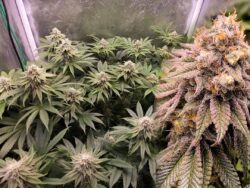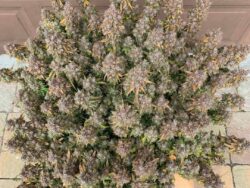These days serious growers always choose LED over HPS grow lights. The choice of good quality LED cannabis grow lights has never been better. Efficiencies are next-level compared to LED lights from just a few years ago. But the cannabis grow light spectrum often differs slightly from one manufacturer to the next. We explain what this means to you.
Cannabis grow light spectrum guide

What does light spectrum mean?

Light spectrum describes the different individual light wavelengths that make up the overall light given to the cannabis plant. Cannabis needs a range of wavelengths to grow in each stage of growth. Of particular value to the cannabis plant are red and blue light wavelengths.
Some early LED grow lights contained just red and blue LED chips. This gave the light a blue-purple hue, known affectionately as ‘blurple’ LED lights.
More modern LED grow lights have a warm-white (white light containing high levels of red wavelengths) cannabis light spectrum. This makes it far easier for the grower to inspect their plants, with the same (or greater) powerful growth rates seen with original blurple lights.
Competent LED light manufacturers tend to create a warm white spectrum and add sufficient blue LED chips to allow good vegetative growth.
How do different colours of light affect the growth of cannabis?

Natural sunlight contains a wide spectrum of light. Over millions of years plant life has evolved to grow well with natural sunlight. An artificial indoor grow light mimics sun light and optimises it for cannabis growth. A good quality modern LED provides an easy working environment to appreciate, care for and inspect your plants for signs of pests, disease, nutrient signals etc. But it will also contain plenty of red and blue light to allow strong growth from cannabis seed to harvest.
Blue light
Blue light provides the most energetic, shorter wavelengths at a higher frequency than red light. It is valuable in early vegetative growth.
During Spring and early summer sunlight contains a higher proportion of blue light. Blue light has a hugely positive effect on chlorophyll formation, which helps plants absorb more light. This promotes leafier plants with shorter stems – desirable traits in veg growth.
Some growers with adjustable-spectrum LED grow lights use blue-dominant light during veg and sometimes at the end of bloom (others will use blue-dominant metal halide lights at the end of bloom). This is said to boost terpene production dramatically, allowing superior taste and flavour.
Green light
Green light doesn’t have a major influence of cannabis growth, although some research suggests that a small amount of green light may be useful in certain photosynthetic reactions.
Because green light has so little effect on cannabis, some growers use green-coloured head lamps to inspect their plants during the lights-off period without disturbing the cannabis plants or interrupting their ‘sleep’ period.
However, not everyone is convinced about the safety of green-light headlamps. There are several online reports from growers who feel that green-light plant inspections during the ‘lights off’ period has caused subsequent issues. And with so many warm-white spectrum LED grow lights available it is easier to check plant health during the lights-on period.
Red light
Red light is of greatest value during bloom. Increasing the intensity of red light wavelengths during bloom promotes flowering and production of new bud sites. That’s why growers steadily increase light power as the plant blooms. With high red light levels and intense light intensities yields are optimised.
UV light
UVA & UVB wavelengths occur naturally in sunlight. However, they are difficult wavelengths to replicate in grow lights. At the time of writing (late 2023), most LED/HPS grow light produce relatively little UVA & UVB. The most cost-effective way to add UVA &UVB light wavelengths is with a supplemental UVA/UVB fluorescent light.
Serious growers tend to work with supplemental UVA/UVB light where it not only maximises cannabinoid production but increases terpene production significantly.
Best cannabis grow lights spectrum by growth stages

Most cannabis growers buy a single LED light which should provide sufficient light for healthy growth in seedling stage, veg & bloom. These are referred to as full spectrum lights since they give good plant growth/development in all stages of growth. A minority of growers, often the most serious growers, have a supplemental UVA/UVB light as well. Migro are a respected supplier of UVA/UVB lights.
Seedling stage
Required light intensities are low. Check your grow light recommendations to ensure you have the correct hanging height and power settings. At this stage the type of grow light isn’t critical. Some growers use dedicated low-power LED or T5-style fluorescent tubes for their seedlings. But many use their LED/HPS lights at low power settings with a high hanging height.
Once the seedling is a couple of weeks old, the light intensities will need increasing a little to support vegetative growth. Often a cannabis light cycle of 20-24 hours of daily light is used with PPFD intensities of around 100-300 µmol/m2/S.
Related:
The cannabis seedling stage
Vegetative stage
During vegetative growth the young cannabis plant begins to grow stems, branches and leaves – but no buds yet. When growing cannabis from autoflower seeds, the plants remain in veg growth for around 4-5 weeks. When growing photoperiod feminised cannabis seeds the grower determines the duration of vegetative growth. Typical light intensities of 400-800 µmol/m2/s PPFD are used during vegetative growth.
Related:
The cannabis vegetative growth stage
Flowering stage
During the cannabis bloom stage your plant will have its greatest need for high intensity light rich in red wavelengths. Light intensities of 800-1000 µmol/m2/s PPFD are used, more if CO2 supplementation is available. During cannabis bloom the red wavelengths power the photosynthesis that creates the buds, resin cannabinoids and terpenes.
If growing autoflower seeds, bloom begins automatically around 4-5 weeks after germination, regardless of the light cycle. Most autoflower seed growers use a 20/4 light cycle from seed to harvest. Those growing photoperiod feminised cannabis seeds initiate bloom when the cannabis light cycle is switched to 12/12 (12 hours of daily light followed by 12 hours of darkness).
Related:
The cannabis bloom phase
Key reasons to consider full spectrum grow lights for cannabis

Any good quality LED grow light should produce a full spectrum light spectrum which will allow strong veg growth and a heavy bloom. Do your research carefully – there are plenty of online forums and social media sites where you can compare performance and real-world results.
Stick to the proven manufacturers and you should get solid results whichever type of cannabis seeds that you grow. The only other grow light you may wish to consider is a supplemental UVA/UVB light. They are not essential, but strongly recommended.
Use supplemental UV lights with caution!
It’s important to add that supplemental UVA/UVB won’t increase harvest quantity. But it will allow improved quality, usually in the form of a richer terpene profile and slightly higher total cannabinoids. But use your UV light carefully, usually for just 2-3 hours each day during the last 2-3 weeks of bloom.
Always switch off your UV light when you enter the tent – the UV light wavelengths will damage your eyes. On the positive side, they also create a hostile environment for flying pests such as fungus gnats and will help limit their numbers.


















